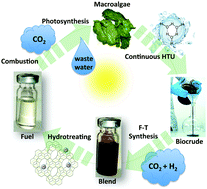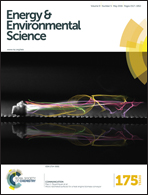From macroalgae to liquid fuel via waste-water remediation, hydrothermal upgrading, carbon dioxide hydrogenation and hydrotreating†
Abstract
This article showcases a proof-of-concept in the production of high quality renewable biofuel from algae. Here, we introduce a path combining a number of approaches that, when integrated as a whole, create a process that takes algae grown in waste-water through to a liquid fuel containing fractions ready for blending with regular gasoline, jet fuel and diesel. With the overarching goal of reducing the nitrogen content invariably associated with whole algal biomass, we apply a number of approaches including (i) nutrient starvation to reduce the internal nitrogen of the freshwater alga Oedogonium (ii) continuous co-solvent (10 wt% n-heptane) hydrothermal liquefaction (HTL) to produce a non-polar biocrude containing <1 wt% N; (iii) blending the biocrude with green feed produced from the hydrogenation of CO2 to obtain <0.5 wt% N; (iv) hydrogenation and hydro-isomerization of the blend in two stages over nanodisperse silica-supported Ni2P (achieving 630 ppm N) and acidic zeolite-supported Pt catalysts respectively to produce a synthetic paraffinic mixture (SPM) containing 277 ppm N and 0.12% O. With the incorporation of renewable H2 (which can be from gasification of polar organics produced in the solvent HTL, or other renewable sources) and captured CO2 the process demonstrates a new and technically cohesive approach to the production of renewable, high-quality biofuels for demanding transport applications.


 Please wait while we load your content...
Please wait while we load your content...